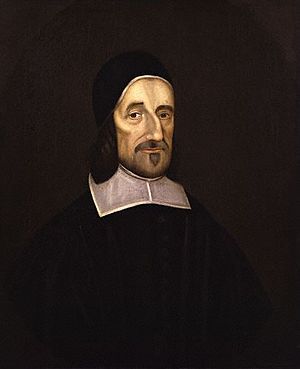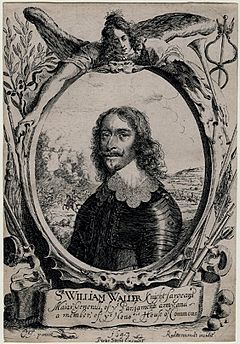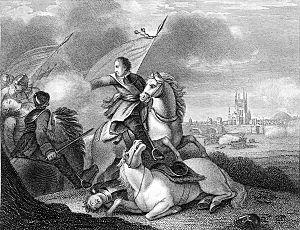Worcestershire in the English Civil War facts for kids
Worcestershire was a very important place during the English Civil War. It was where the first battle and the very last battle of the war happened.
The first fight, called the Battle of Powick Bridge, took place on September 23, 1642. It was a small battle between horse soldiers, and the King's side (the Cavaliers) won. The final battle, the Battle of Worcester, happened on September 3, 1651. This battle was a big one and ended the war. The Parliament's side (the Roundheads) won, and King Charles II had to run away as a wanted person.
During the First Civil War, the King's supporters mostly controlled Worcestershire. However, Parliament's forces often surrounded their strongholds. For example, the city of Worcester was attacked twice before it finally gave up on July 23, 1646. After the war, many Royalist families in Worcestershire lost their lands. They had to pay a fine to get their property back. This fine depended on how much money their land made and how much they helped the King during the war.
The Second English Civil War (1648) didn't involve Worcestershire much, except for a small event called the Broadway Plot in January 1648.
During the Third English Civil War, King Charles II led an army, mostly from Scotland, to Worcester. He hoped that English Royalists would join him. A few did, but Charles's army was surrounded by a much bigger Parliament army led by Oliver Cromwell. Cromwell's army completely defeated them. Cromwell even called this victory a "Crowning Mercy."
Contents
Why the War Started in Worcestershire
King Charles I made some choices that made people unhappy. He ruled without Parliament, which meant he had to raise taxes on goods coming into the country. These taxes, like 'tonnage and poundage', made trade less profitable. This upset people in cities like Worcester. Another tax, called Ship Money, was also very expensive for Worcester in 1636. People like Richard Baxter, a religious leader in Kidderminster, saw that many people in the county were against the King's rules. They thought Charles I was trying to become a ruler with too much power, without Parliament's say.
Worcestershire also had problems with land. The King tried to take over common lands like Malvern Chase and sold parts of Feckenham Forest in the 1630s. This caused riots and made poor people lose their homes. These people had depended on using these royal lands. People in the Vale of Evesham were also upset because the King stopped them from growing tobacco, which was a good business for them.
The King's religious choices also made people suspicious. Even though some rich families in Worcestershire were Catholic, most people were Anglican. Some towns in the north, like Kidderminster, had more radical Protestants. Charles seemed to favor Catholics, and his changes to the Church of England, led by William Laud, looked like Catholic practices. Many people didn't like this. In the early 1640s, stories about Protestants being killed in Ireland made people fear Catholic plots. This led to anti-Catholic riots in Bewdley in late 1641. Local armies were told to watch out for secret plans in the following months.
How the War Began
Many people in England, including Worcestershire, didn't really want to fight. They just wanted to avoid conflict. Different parts of the county had different feelings. For example, Evesham and Kidderminster had many people who supported Parliament.
The main reason the war started was a fight between Parliament and the King over who controlled the country's army, called the Trained Bands. Normally, the King controlled these forces. In Worcestershire, the rich families who supported the King tried to control the Trained Bands. But the city of Worcester tried to take control of its own forces from the county starting in 1641.
At first, Worcester city wasn't sure which side to support. In June 1642, they even created their own neutral armed forces. But in mid-July, the King's supporters started organizing soldiers at the Town Hall. Then, the city council decided to support Parliament. This happened after two Worcestershire Members of Parliament, Humphrey Salway and John Wylde, came back and encouraged the city against the King. A group of important citizens then said the King's way of raising an army was illegal. They also gathered signatures to support Parliament's plan for the army.
However, the King's supporters from across Worcestershire kept organizing the Trained Bands for the King. In early August, another group of important citizens ordered the arrest of Parliament's leaders. They also called the Trained Bands to Pitchcroft on August 12. But the soldiers were not very good, and their weapons were makeshift. When the forces were called again on August 22, when the war officially started, only 500 men showed up. This was much fewer than expected, showing that many people didn't want to fight.
Around the same time, Parliament's army was moving from London to secure Coventry and Warwick. The King's Trained Bands in Warwickshire asked Worcestershire for help. But they didn't get it because the leader didn't want to force his troops to fight outside the county. This showed that even early on, there was a problem between local armies and the need for a national fighting effort.
Royalist Control of Worcestershire
Only a small number of rich people in Worcester were active leaders for the King's side. About 25 people were the main organizers for the King in the county. At the end of the war, 44 were arrested. These numbers are much lower than the total number of rich people, meaning most tried to stay out of the conflict.
Worcester and the county were mostly controlled by the King's side at the start of the war. The cathedral was used to store weapons, possibly as early as September 1642. The King's supporters were storing weapons there when Essex, a Parliamentarian leader, briefly took the city after the Powick Bridge fight. Parliament's troops then damaged the cathedral. They broke stained glass, destroyed the organ, and ruined library books and monuments.
Worcester, Dudley, and Hartlebury were strongholds for the King's forces in the county. Worcester had to pay a lot to feed and house many of the King's soldiers. During the King's control, the areas outside the city walls were destroyed to make defense easier. The military leaders took over the job of keeping up the defenses. High taxes were put in place, and many men were forced to join the army. Towards the end of the war, many more people in Worcester needed help for the poor, and trade had gone down a lot.
The whole county faced similar problems. It had to support a large army that wasn't producing anything. Both sides collected heavy taxes. Sometimes, armies would take supplies, which was very hard on people. For example, in 1643, the King's troops used violence and destroyed pea and bean crops in Amscote and Treadington when people tried to refuse their demands. The King's horse soldiers took so much food from northern Worcestershire that towns like Droitwich, Bromsgrove, King's Norton, Alvechurch, and Abbots Morton couldn't pay their taxes.
Worcestershire was close to Parliament's forces in Birmingham (north), Warwickshire (east), and sometimes Bristol and Gloucestershire (south). This made the county easy to raid for supplies.
Still, the county was very important for the King's side. It was a bridge from their lands in the west, including Wales and Ireland, to their main base in Oxford. Worcestershire also had factories that could make weapons and ammunition for the King's army.
In June 1644, General William Waller's army of about 10,000 men chased the King's army into Worcestershire. The King's army was retreating from Oxford. People in Evesham helped Waller by fixing their bridge, which had been broken to slow him down. Evesham was heavily fined, and its Mayor, George Kempe, was arrested after Waller left. Waller's army took whatever they could from the land in June, first in the Vale of Evesham, then Bromsgrove and Kidderminster. After failing to take Bewdley, they occupied Droitwich before returning to Evesham. Some of Waller's soldiers were not well-behaved, and it was hard to tell the difference between taking supplies and just stealing. After Waller left, the King's army in the Vale of Evesham had to bring in supplies from other places, like Bridgnorth and Shropshire, because so much had been taken.
The Scottish army that came into Worcestershire in 1645 also had a very bad reputation. They were said to have taken sheep and stolen many different things like clothes, household items, wagons, and food. There were also reports of them destroying crops as they moved through the area.
The King's stronghold at Hartlebury also became known for taking local supplies, which made the nearby areas very poor during the war.
Groups called Clubmen formed in west Worcestershire later in the first war. Their goal was to keep both armies and their demands away from regular people in the countryside. They wanted to stop armies from destroying and taking supplies. There was also anger because many Catholics were given important roles in the county. The Clubmen's message at Woodbury Hill said they would not obey any Catholic, and that Catholics should not be trusted in any government job.
As the King's power fell apart in May 1646, Worcester was surrounded. Worcester had about 5,000 regular people and about 1,500 of the King's soldiers. They faced a force of 2,500 to 5,000 soldiers from the New Model Army (Parliament's main army). Worcester finally gave up on July 23, ending the First Civil War in Worcestershire. When the city surrendered, the King's leaders had to promise not to fight against Parliament again. But some of them broke this promise in 1651.
Scottish Troops and the Third Civil War
In 1651, a Scottish army marched south to help Charles II try to get his crown back. They entered Worcestershire. The 16,000 Scottish soldiers made Worcester's council vote to surrender as they came closer. The council feared more violence and destruction. Parliament's soldiers decided to leave for Evesham because there were too many Scots. The Scots stayed in and around Worcester, which was very expensive and caused new worries for the people living there. Only a few local forces joined the Scots, including a group of 60 men led by John Talbot.
The Battle of Worcester (September 3, 1651) happened in the fields west and south of the city, near the village of Powick. Charles II's army was easily beaten by Cromwell's forces of 30,000 men. Charles II went back to his headquarters in what is now called King Charles House. From there, he escaped north out of the county and eventually to France. Some Catholic rich families in Worcestershire helped him.
After the battle, Parliament's army heavily looted Worcester. It's estimated they caused £80,000 worth of damage. The city was still in debt from this in the 1670s. The Scottish soldiers who weren't captured were attacked by local people as they ran away. About 10,000 prisoners, mostly Scots, were taken. Some were sent to work on draining the Fens (wetlands), and others were sent to the New World to work as forced laborers.
Timeline of the English Civil War in Worcestershire
Here is a timeline of the English Civil War in Worcestershire.
First English Civil War Events
1642: King Charles I moved from Nottingham to Shrewsbury. The Earl of Essex, who led Parliament's army, was told to stop the King from going to London. So, he marched from Northampton to Stratford-on-Avon, then to Pershore and Worcester. Just before Essex arrived, the first big fight between horse soldiers happened at Powick Bridge. Charles finished getting ready and marched past Wolverhampton and Birmingham towards Banbury. This put him between Essex and London. He then turned around and defeated Essex at the Battle of Edgehill. Charles slowly marched towards London. After the Battle of Brentford, he went back to Reading and then to Oxford. Because the King's forces moved towards London, Parliament's troops left Worcestershire.
1643: The King set up his main base in Oxford. He really wanted to control the high lands of the Cotswolds and the Severn river area. Parliament had two armies. Their plan was for these two armies, one led by Essex near Reading and the other by William Waller near Bristol, to join up and take Oxford. Essex took Reading. Waller, starting from Gloucester, cleared the county. By taking Hereford, he cut off the King's way to Wales. To make the Severn Valley safe, Charles surrounded Gloucester. But Essex was able to break the siege and save Gloucester.
1644: Again, Parliament's forces tried the same plan as the year before. Essex and Waller were supposed to join and march on Oxford. They did, and almost caught Charles I. But he escaped, marching through Broadway to Evesham, Pershore to Worcester, and then to Bewdley. Waller followed him, but the two armies didn't fight directly. The only fighting was when Wilmot tried to help Dudley Castle, which was being surrounded by Lord Denbigh. Charles went back towards Oxford, followed by Waller. Waller was defeated by Wilmot at the Battle of Cropredy Bridge. Charles then returned to Worcestershire and stayed in Evesham for several days.
1645: Edward Massey, the leader of Gloucester, attacked and took Evesham. This cut off the King's army's path from Worcester to Oxford. Charles marched to Inkberrow, Droitwich, Bromsgrove, and then to Leicester and Naseby. There, he was defeated. He then went back through Kidderminster and Bewdley to Hereford and South Wales. The Scottish army came to help the English. They marched to Alcester on their way to attack Worcester. But they turned off to Droitwich, Bewdley, and then to Hereford, which they surrounded. Charles marched north and managed to get back to Oxford. After gathering some troops, he marched to help Hereford. He stayed several days in Worcester, then marched from there to Bromyard and on to Hereford. But when he got close, the Scots ended their siege. They marched to Gloucester, crossed the Severn, then went through Cheltenham and Evesham to Stratford-on-Avon on their way towards Newark.
1646: During the winter, an army for the King was gathered in Wales, Herefordshire, and Worcestershire. They marched towards Oxford. But Parliament's troops met them near Stow-on-the-Wold and destroyed them. Soon after, Charles left Oxford and gave himself up to the Scots. He ordered his captains and officers to give up the places they held. Dudley Castle surrendered, and so did Hartlebury. Worcester was surrounded and held out until July, when it had to surrender. This included Madresfield and Strensham. With their surrender, the First Civil War ended in Worcestershire.
Second Civil War Events
1647: Throughout the year, Royalist secret plans continued to try to free the King or start a new uprising. The main one was the Broadway Plot.
1648: The Royalist plot led to the Second Civil War. A major event was the siege of Colchester. An attempt at an uprising, organized by Colonel Dud Dudley, happened in Worcestershire. But it was stopped. Dudley was taken prisoner, sent to London, and sentenced to die. The morning before he was to be executed, he escaped.
1649: King Charles I was executed. Charles II went to Scotland and was declared King of Scotland. Parliament's troops were busy stopping rebellions in Ireland.
Third Civil War Events
1650: Oliver Cromwell, after finishing his work in Ireland, went to Scotland. He defeated Leslie and the Scots at the Battle of Dunbar.
1651: After many talks and movements, Charles II invaded England at the end of July. He marched through Carlisle towards London. When he reached Stafford, it was decided to stop for more soldiers from Wales. To meet these men, Charles marched to Worcester. Meanwhile, Cromwell went down the east coast, then marched across to Evesham. This put him between Charles and London. Cromwell then moved on to Worcester, attacked, and completely defeated Charles at the Battle of Worcester.
More to Explore
- Governor of Worcester
- Battle of Kings Norton
- Clubmen
- Escape of Charles II
- Tinker Fox
- Sir Thomas Lyttelton
Images for kids





